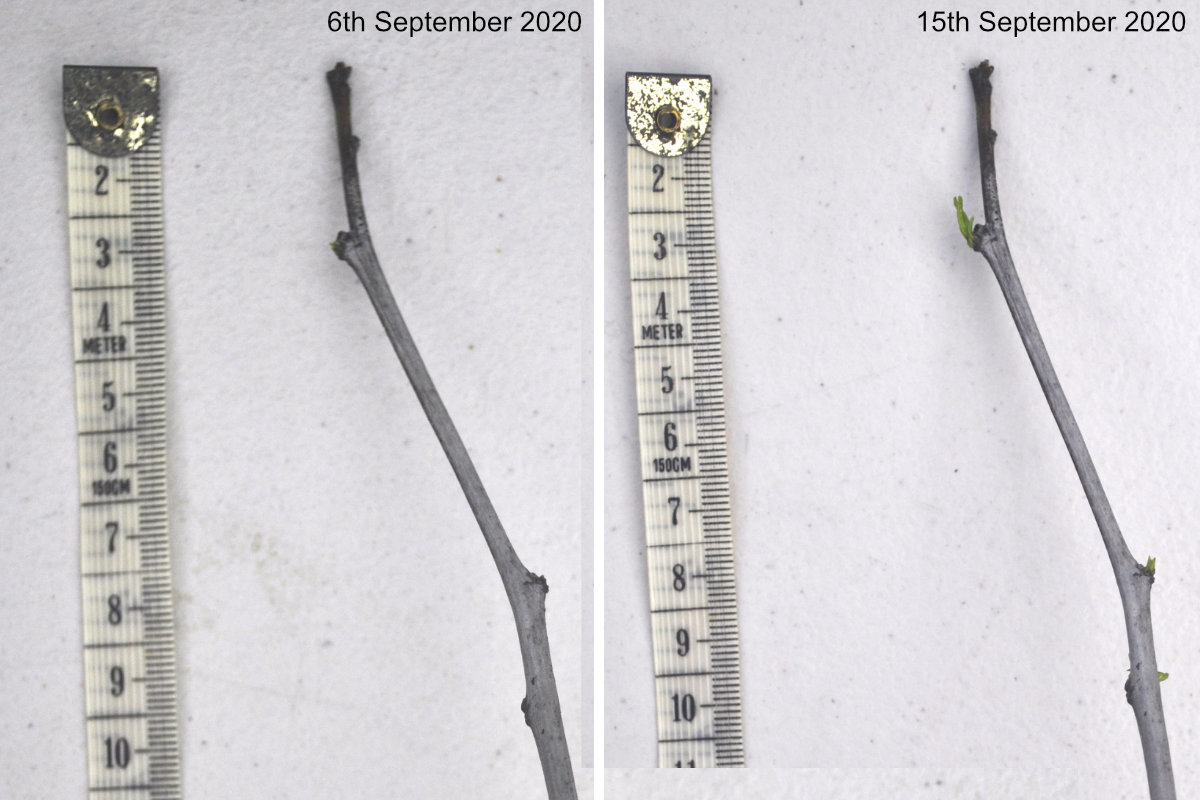Photo Journal: A Ta-Jan Exiting Ecodormancy
Below is the same photo of the young Ta-Jan mentioned back on 1st September 2020 in this post.

© Optimate Group Pty Ltd
The photo below was taken today, 15th September. This tree has not seen soil since July, as part of a little experiment to a) show how tough these trees are, and b) show how much energy is contained in the roots and trunk to sustain any particular one through and post-dormancy. It has been, and still is, kept cool and moist in wood shavings, but without having seen soil, or much sunlight, all this time.
This tree is approximately 560 mm long from trunk tip to root tip in a vertical line, ignoring the bends in the roots. Approximately 360 mm is trunk (including the graft), and the root section, if straightened, would measure approximately 300 mm.

© Optimate Group Pty Ltd
Can you see the new leaves growing about 30 mm from the top, on the left? These are about 8 mm long and were barely an open bud back on September 1st.
Let’s zoom in on that trunk now. (Note that the first photos date from the 6th, not 1st September.)

© Optimate Group Pty Ltd
And again:

© Optimate Group Pty Ltd
Can you see that the very tip is heavily reddish-brown, and that the buds and nodes are also noticeably reddish-brown against the more grey wood? And that the grey wood itself has (faint) reddish-brown streaks along it?
The other side of the trunk happens to be mostly reddish-brown with grey streaks, and with a very green tip:

© Optimate Group Pty Ltd
These are the colours jujube wood cycles through as it ages: green for the newest growth, reddish-brown for the next, and grey for the oldest.
The two pictures below, taken last summer 2019 along a Li trunk, show this well:

© Optimate Group Pty Ltd
The newest growth is a vivid green, transitioning to a reddish-brown as it ages during a season, transitioning again to grey as it ages more. It is very easy to age jujube wood by its colour (and texture, from very smooth green to ever roughening grey with each passing year). Last year’s wood is grey and rough, while a current year’s growth always begins a vivid green that has turned reddish-brown by the following autumn. Only the very newest growth remains green by summer’s end.
As a jujube tree enters dormancy, all its wood, regardless of colour and age, dulls to the same grey tones. This colour change may subconsciously register to make these trees look even more lifeless than they are throughout winter. But these colours return in a gentle flush come spring, as shown by the Ta-Jan above. It too was completely grey over winter, but has now picked up where it left off last season. In time that green tip will become reddish-brown over this season, and the reddish-brown will transition to grey during this season.
Nothing says ’spring’ to me more than seeing the first red flushes around the buds and nodes, and watching them gradually extend along the trunk and branches!
About the Author
BSc(Hons), U.Syd. - double major in biochemistry and microbiology, with honours in microbiology
PhD, U.Syd - soil microbiology
Stumbled into IT and publishing of all things.
Discovered jujube trees and realised that perhaps I should have been an agronomist...
So I combined all the above passions and interests into this website and its blog and manuals, on which I write about botany, soil chemistry, soil microbiology and biochemistry - and yes, jujubes too!
Please help me buy a plant if you found this article interesting or useful!